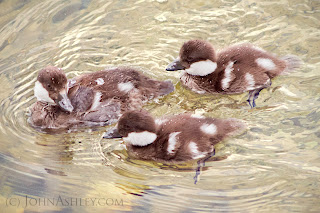 |
| A super-duper Barrow's Goldeneye mom with 30 chicks in tow |
During the 12-24 days of egg laying - and even sometimes during incubation - some non-nesting young females will also lay eggs in the older hen's nest when she leaves to feed. This behavior is called "egg dumping" or "nest parasitism." Nests that have been parasitised end up with three extra eggs, on average. If a parasitised nest accumulates 20 eggs or more, the hen will abandon her nest and all of the eggs. But with a normal sized clutch, even though her own eggs were laid over a 12-24 day period, all of them will hatch within 12 hours of each other because of her delayed incubation. All of the eggs started "cooking" at the same time.
So you often see female Goldeneyes with 6-15 chicks swimming along behind her, 6-12 of her own and maybe a few extras. But you sometimes see Goldeneye moms with 20-30 chicks in tow, or with a group of chicks that are different sizes and ages.
 |
| Different aged Barrow's Goldeneye chicks in one brood |
Before a female Goldeneye begins nesting, she spends her days on a spring breeding territory that's defended by her very aggressive mate. Their pair bond was established back in November, but it dissolves when she begins incubation.
After fledging her young, the female leads her chicks to the water and takes them to a summer brood territory - a portion of the lake that she defends from other Goldeneye families - that is often in a different part of the lake from her spring breeding territory.
Now that it's summer, it's the females with young who are very aggressive. Where brood territories meet, violent clashes take place between these females. During these melees their chicks can easily get mixed and swapped. Afterwards, if the new additions are similar in age, the female takes them in as her own. This is one form of "creching," where one adult bird tends to another's young. But if the unrelated chicks are significantly smaller than her own, she might attack them instead. She will even attack adults and juveniles of other duck species, if they dare swim into her brood territory.
If a hen's brood is reduced by more than about half, she will abandon them to fend for themselves. Some of these abandoned chicks will join up with other broods. Their survival rate is high if they are the same age or older than their new brood mates. But smaller chicks from broods that hatch later in the summer often don't fare as well as the earlier hatching chicks, if these late chicks get mixed or abandoned.
In the family of birds, the precocial Goldeneye chicks are more independent than most, and some will survive on their own even without a parent looking after them.
In the family of man, this all makes perfect sense to me. I come from a family of seven boys, and I have six step-brothers from two, all-too-kind parents. All of us boys got thrown in together and, as the youngest by far, I just barely survived the pecking order long enough to fledge from the maternal nest. Elder is better off than younger, but the lucky duckling trumped them all.

